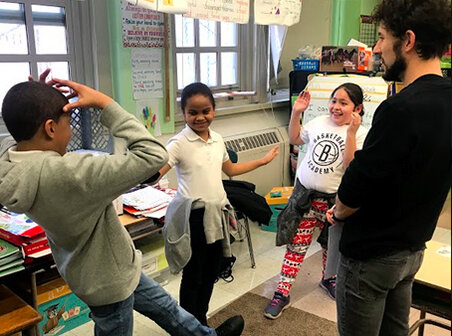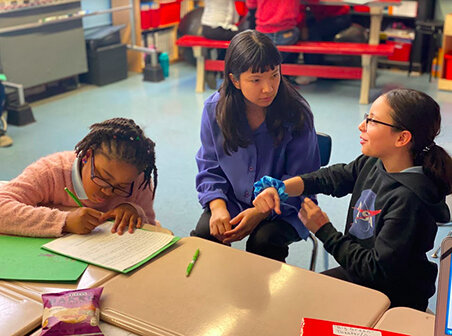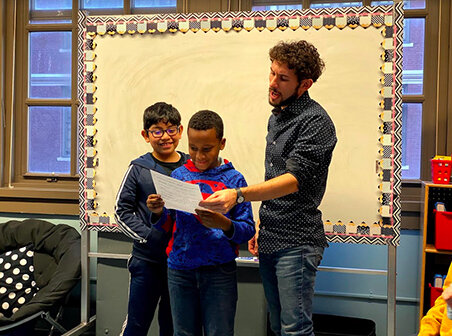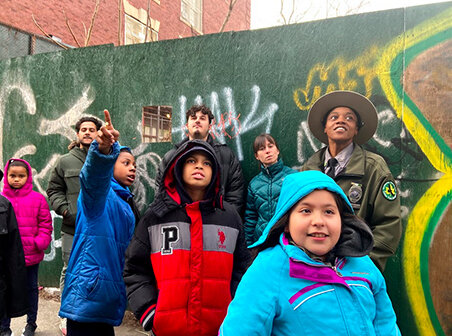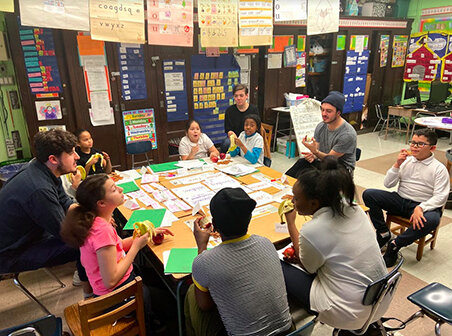Reflections from Big Green Theater teaching artists
Our beloved Big Green Theater program was cut short in 2020 due to the COVID-19 outbreak, but The Bushwick Starr and Superhero Clubhouse remain unwaveringly dedicated to our students and the families, friends, and staff of BGT. As eco-conscious theater artists, we are built to adapt, think creatively, re-imagine resources, and practice resilience. And so, we are excited to announce that we have created a new vision for sharing the student’s plays and honoring all the hard work that took place in the classrooms over the last few months. We will be announcing the project next week, so stay tuned! In the meantime, we’re wrapping up the after-school portion with some meaningful reflections from BGT’s teaching artist team.
Dominique Brillon (Co-Lead Teaching Artist, PS196):
In Big Green Theater, our students learned how climate change affects their lives on both a global and local level. We met with educators from El Puente, a community human rights institution in North Brooklyn, who taught the students about justice in relation to climate change. In this portion of the program, our students were taught that, as a younger generation of people of color, they are at the frontline of climate change. The students learned about the difference between equity and equality, and then were able to discuss how resources are more often provided and afforded to white and affluent communities. They learned how POC communities are the ones to lead initiatives and create inclusive policies that consider what wider communities need.
Through playwriting, students were then able to use their voices to address climate change in the world they created, from the point of view of the characters they wrote. As one of our characters, Emaily, said, “People of color are most at risk of losing their homes because of environmental injustice. We need to make sure that everyone gets back on their feet.” The action of playwriting empowered students to imagine new realities where all of their characters’ different needs were met.
Rasheedat Badejo (Assistant Teaching Artist, PS75):
The structure of the Big Green Theater classroom is one that creates room for students with different learning styles and abilities to thrive without judgement. The students are taken through the playwriting process, but with an emphasis on accessibility. They are encouraged to follow their imaginations with the adult artists acting as a springboard and a support for the young creators to bounce their ideas off of. When it is time to put ideas to paper, the students are allowed to write, draw, and use the adults in the room as personal scribes for their scenes, thus allowing the sometimes daunting act of creating seem not so scary or rigid. The structure also causes the adult artists to be active participants in the imaginations of the students.
Allisha Edwards (Assistant Teaching Artist, PS196):
The Teachers at BGT teach and guide the kids to write their own stories. Every step of the way the kids offer thoughts, ideas and critiques that help form their script. It is such a magical thing to watch students who may not have had a lot of agency yet in their life, find creative autonomy as well as hone collaboration skills. It is evident to the teachers in the classroom the change in the students throughout the semester. This semester we watched one student who was too shy to speak on the first day find pride in their work and a voice in the classroom by the end of their time. We saw another student who was struggling to speak English, push herself to read out loud to the class and all of her classmates cheered her on. We see the kids form bonds with each other and look forward to being in the program everyday.
Kimberly Pereyra Monero (BGT Intern, PS75):
The environment at Big Green Theater provides students with the confidence to tell their stories and know that they will be heard. The way in which the program dynamically engages with students in the innovation of a story certainly impacts the students’ abilities to advocate in a creative way and address environmental injustice. This program certainly allows students to address this issue in their own unique way through arts and writing, leading each of them to embrace their ideas, their interests and their hopes in a constructive and detailed way, to share them and guide others to a potential resolution.
Dylan Guerra (Co-Lead Teaching Artist, PS196):
One of the most beautiful things about Big Green Theater is that it teaches kids their voices are important- that what they have to say matters. In creating their own worlds they are realizing the power that they have with their words; that they can inspire change through fictional storytelling. The students cared so deeply about the made-up city and the characters who inhabit it, it even began to affect the way they treated each other. By creating characters who are affected by climate change, and having those same characters affect climate change, the students began to realize that they have an ability to change the climate crisis. And that they can be artists while they do it.
One young student created the character of Ms.Water (a woman made of water who kept expanding because the wetland that contained her was destroyed). This student at first tried to come up with easy solutions for Ms.Water- put her in a big pool, use a giant sponge- but then she realized that she was trying to make an impact with the character. She realized that she could give her opinion and provide her take on solutions regarding climate change through Ms.Water. And so she decided that when they tried all the different “easy” solution to containing Ms.Water they wouldn’t work, and instead she anchored her to the main plot and crafted a funny and heartfelt story about a woman made of water trying to save the town as well as herself.
Anna Chen (BGT Intern, PS196):
At the Big Green Theater Program, students are not only exposed to environmental issues and climate change, but they are also exposed to music, creativity, and a world of imaginations. Not only have they created their own scripts to a play that addresses fundamental environmental concerns, but they have created their own lyrics and songs to accompany the plays as well. Through their music, they are able to convey the necessity of keeping every aspect of our planet such as the air or water clean and safe. In one particular moment in the classroom, the children learned to sing a song for water where they recognized the importance of water in people’s daily lives. While it was in a different language, it was a unique experience that brought the children closer to nature and towards environmental justice. Furthermore, another particular moment can be seen when a professional composer sat with the children in order to compose the music with the lyrics. The children had a fun and enjoyable time as they explained what they wanted their music to sound like. Some of them eagerly touched the guitar as they wanted to play the song themselves. It has been really motivating to see the children’s excitement and energy in participating in arts and music at the program.

